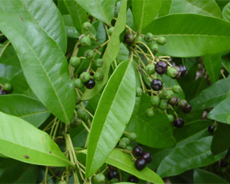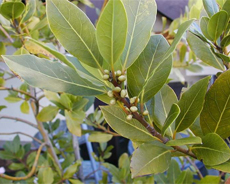
Culinary
Culinary use of the term "herb" typically distinguishes between herbs, from the leafy green parts of a plant (either fresh or dried), and spices, from other parts of the plant (usually dried), including seeds, berries, bark, root and fruit. Culinary herbs are distinguished from vegetables in that, like spices, they are used in small amounts and provide flavor rather than substance to food. Culinary herbs can take the form of both seasonings and teas.
Many culinary herbs are perennials such as thyme or lavender, while others are biennials such as parsley or annuals like basil. Some perennial herbs are shrubs (such as rosemary, Rosmarinus officinalis), or trees (such as bay laurel, Laurus nobilis) – this contrasts with botanical herbs, which by definition cannot be woody plants. Some plants are used as both an herb and a spice, such as dill weed and dill seed or coriander leaves and seeds.
Allspice
Allspice is the dried fruit of the Pimenta dioica plant. The fruit is picked when it is green and unripe and, traditionally, dried in the sun. The name "allspice" was coined as early as 1621 by the English, who thought it combined the flavor of cinnamon, nutmeg and cloves.
Allspice is one of the most important ingredients of Caribbean cuisine. It is used in Caribbean jerk seasoning and in pickling; it is also an ingredient in commercial sausage preparations and curry powders. Allspice is also indispensable in Middle Eastern cuisine, particularly in the Levant, In Palestinian cuisine, for example, many main dishes call for allspice as the sole spice added for flavoring. In America, it is used mostly in desserts, Allspice is commonly used in Great Britain, and appears in many dishes, including cakes. Even in many countries where allspice is not very popular in the household, such as Germany, it is used in large amounts by commercial sausage makers. Allspice is also a main flavor used in barbecue sauces. In the West Indies, an allspice liqueur called "pimento dram" is produced.
Basil
Basil, is a common name for the culinary herb Ocimum basilicum Basil, originally from India, is best known as a culinary herb prominently featured in Italian cuisine, and also plays a major role in the Northeast Asian cuisine of Taiwan and the Southeast Asian cuisines of Thailand, Vietnam, Cambodia, and Laos. Depending on the species and cultivar, the leaves may taste somewhat like anise, with a strong, pungent, often sweet smell.
There are many varieties of Ocimum basilicum, as well as several related species or species hybrids also called basil. The type used in Italian food is typically called sweet basil, as opposed to Thai basil (O. basilicum var. thyrsiflora), lemon basil (O. × citriodorum) and holy basil (Ocimum tenuiflorum), which are used in Asia. While most common varieties of basil are treated as annuals, some are perennial in warm, tropical climates, including holy basil and a cultivar known as 'African Blue'.
Basil is originally native to India and other tropical regions of Asia, having been cultivated there for more than 5,000 years.
Bay Leaf
Bay leaf refers to the aromatic leaf of the bay laurel Fresh or dried bay leaves are used in cooking for their distinctive flavor and fragrance. The leaves are often used to flavor soups, stews, braises and pâtés in Mediterranean cuisine. The fresh leaves are very mild and do not develop their full flavor until several weeks after picking and drying.
The bay laurel tree has been cultivated since the beginning of recorded history; it originated in Asia Minor, and spread to the Mediterranean and other countries with suitable climates. Bay leaf is not grown in northern regions, as the plants do not thrive in cold climates.
Bay leaves are a fixture in the cooking of many European cuisines as well as in North America. They are used in soups, stews, meat, seafood and vegetable dishes. The leaves also flavor many classic French dishes. The leaves are most often used whole and removed before serving In Indian and Pakistani cuisine; bay leaves are often used in biryani and other rich spicy dishes - although not as an everyday ingredient in home cuisine.
Caraway
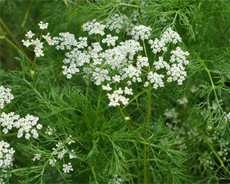

Caraway is a biennial plant native to western Asia, Europe and Northern Africa.
The plant is similar in appearance to a carrot plant, with finely divided, feathery leaves with thread-like divisions, growing on 20–30 cm stems. The main flower stem is 40–60 cm tall, with small white or pink flowers in umbels. Caraway fruits (erroneously called seeds) are crescent-shaped achenes, around 2 mm long, with five pale ridges.
The fruits, usually used whole, have a pungent, anise-like flavor. They are used as a spice in breads, especially rye bread.
Caraway is also used in desserts, liquors, casseroles, curry and other foods. It is more commonly found in European cuisine. For example, it is commonly used in British [Caraway seed cake] and is also added to sauerkraut. It is also used to add flavor to cheeses such as bondost, pultost, nøkkelost and havarti. Akvavit and several liqueurs are made with caraway. In Middle Eastern cuisine, caraway pudding is a popular dessert during Ramadan. The roots may be cooked as a root vegetable like parsnips or carrots.
Caraway seed oil is also used as a fragrance component in soaps, lotions, and perfumes.
Chili Peppers
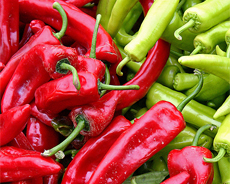

Chili Peppers are the fruit of plants from the genus Capsicum, members of the nightshade family, Solanaceae.
Chili peppers originated in the Americas. After the Columbian Exchange, many cultivars of chili pepper spread across the world, used in both food and medicine.
Chili peppers have been a part of the human diet in the Americas since at least 7500 BC. There is archaeological evidence at sites located in southwestern Ecuador that chili peppers were domesticated more than 6000 years ago, and is one of the first cultivated crops in the Central and South Americas.
The substances that give chili peppers their intensity when ingested or applied topically are capsaicin and several related chemicals collectively called capsaicinoids. Capsaicin is the primary ingredient in the pepper spray used as an irritant weapon..
When consumed, capsaicinoids bind with pain receptors in the mouth and throat that are responsible for sensing heat. Once activated by the capsaicinoids, these receptors send a message to the brain that the person has consumed something hot. The brain responds to the burning sensation by raising the heart rate, increasing perspiration and release of endorphins.
Chives


Chives (Allium schoenoprasum) are the smallest species of the edible onions. A perennial plant, they are native to Europe, Asia and North America. Allium schoenoprasum is the only species of Allium native to both the New and the Old World.
The name of the species derives from the Greek skhoínos (sedge) and práson (leek). Its English name, chive, derives from the French word cive, from cepa, the Latin word for onion.
Chives are a commonly used household herb, frequently grown in gardens and found in grocery stores. In culinary use, chives leaves (straws) are shredded for use as a seasoning for fish, potatoes, soups, and other dishes. Chives have insect-repelling properties that can be used in gardens to control pests.
Chives are grown for their leaves, which are used for culinary purposes as flavoring herb, and provide a somewhat milder flavour than those of their neighbouring Allium species.
Chives are one of the "fines herbes" of French cuisine, which also include tarragon, chervil and parsley.
Chives can be found fresh at most markets year-round, making them a readily available herb.
Cinnamon


Cinnamon is a spice obtained from the inner bark of several trees from the genus Cinnamomum that is used in both sweet and savory foods. Cinnamon trees are native to South East Asia, and its origin was a mystery to Europeans until the sixteenth century.
Cinnamon is harvested by growing the tree for two years then coppicing it. The next year, about a dozen shoots will form from the roots.
The branches harvested this way are processed by scraping off the outer bark, then beating the branch evenly with a hammer to loosen the inner bark. The inner bark is then prised out in long rolls. Only the thin (0.5 mm (0.020 in)) inner bark is used; the outer, woody portion is discarded, leaving meter-long cinnamon strips that curl into rolls ("quills") on drying. Once dry, the bark is cut into 5–10 cm (2.0–3.9 in) lengths for sale.
The bark must be processed immediately after harvesting while still wet. Once processed, the bark will dry completely in four to six hours, provided that it is in a well-ventilated and relatively warm environment
Cloves
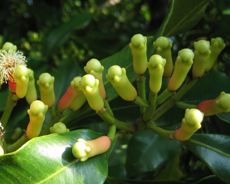

Cloves (Syzygium aromaticum) are the aromatic dried flower buds of a tree in the family Myrtaceae. Cloves are native to the Maluku islands in Indonesia and used as a spice in cuisines all over the world. Cloves are harvested primarily in Indonesia, India, Madagascar, Zanzibar, Pakistan, and Sri Lanka.
The clove tree is an evergreen that grows to a height ranging from 8–12 m, having large square leaves and sanguine flowers in numerous groups of terminal clusters. The flower buds are at first of a pale color and gradually become green, after which they develop into a bright red, when they are ready for collecting. Cloves are harvested when 1.5–2 cm long, and consist of a long calyx, terminating in four spreading sepals, and four unopened petals which form a small ball in the center.
Cloves can be used in cooking either whole or in a ground form, but as they are extremely strong, they are used sparingly. Cloves have historically been used in Indian cuisine Indian cuisine; it is used in almost all rich or spicy dishes.
Dill


Dill (Anethum graveolens) is a perennial herb. Dill originated in Eastern Europe. Although several twigs of dill were found in the tomb of Amenhotep II, they report that the earliest archeological evidence for its cultivation comes from late Neolithic lake shore settlements in Switzerland. Traces have been found in Roman ruins in Great Britain.
Fresh and dried dill leaves (sometimes called "dill weed" to distinguish it from dill seed) are used as herbs, mainly in Sweden, the Baltic, in Russia, and in central Asia.
Like caraway, its fernlike leaves are aromatic and are used to flavor many foods, such as gravlax (cured salmon), borscht and other soups, and pickles (where the dill flower is sometimes used). Dill is best when used fresh, as it loses its flavor rapidly if dried; however, freeze-dried dill leaves preserve their flavor relatively well for a few months.
Dill seed is used as a spice, with a flavor somewhat similar to caraway but also resembling that of fresh or dried dill weed. Dill seeds were traditionally used to soothe the stomach after meals. Dill oil can be extracted from the leaves, stems and seeds of the plant.

